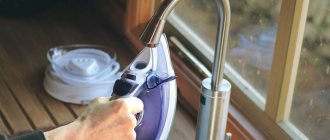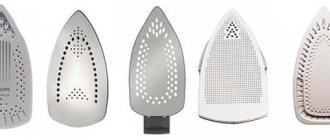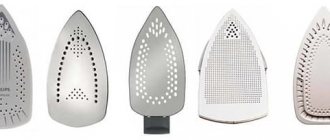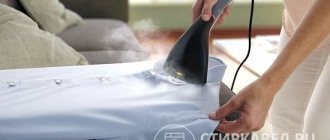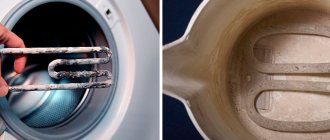Photo: AllaSerebrina/depositphotos.com It happens. You take a snow-white blouse fragrant with air conditioning, start ironing it, anticipating your spectacular appearance at the office, and... you discover a dark mark on it that can hardly be washed off. To prevent this from happening to your favorite things, you need to learn how to properly clean your iron.
What elements need cleaning?
Contamination on any part of the iron can negatively affect the operation of the device. You need to know what kind of contaminants form on different elements in order to properly deal with them and not harm the equipment.
Frame
Dust and dirt accumulate on the body. They clog the holes, which contributes to the breakdown of the power regulator.
Sole
On the sole you can see rust, plaque and traces of melted fabric. Black stains from the soles may remain on clothing, so clean the soles as soon as black deposits form on them.
Water tank
The tank needs to be descaled due to hard water, mold and dirt. Use only special iron fluid and wipe the reservoir after each use to avoid contamination.
Steamer
Scale and mold accumulate in the steam holes, which must be dealt with so as not to stain clothes and prolong the operation of the steaming mechanism. Do not pour water into the steamer “in reserve”; use strictly the required amount.
Removing contaminants from the housing
You should clean the iron not only from the inside (from scale) or from the bottom (from stuck fabric). The body of the device also requires care. Over time, during use, dust and various contaminants accumulate on it, giving the device an extremely untidy appearance. The housing can be cleaned effectively and easily using the following products:
- acid solutions (citric, acetic acid);
- hydrogen peroxide;
- alcohol solution;
- vodka.
Clean the surface with a cloth soaked in the specified substance.
How to effectively clean your iron from carbon deposits
It is important to remove carbon deposits, burnt fabric and traces of rust not only effectively, but also safely for the sole. Follow our instructions for getting rid of carbon deposits using available products.
Soda
Prepare the mixture by mixing 2 teaspoons of baking soda, 1 tablespoon of vinegar and 2 tablespoons of water. Apply the mixture to the sole with a soft cloth and leave for 10 minutes. Rinse off the paste and wipe the sole clean.
Hydrogen peroxide
Soak a cotton pad with hydrogen peroxide and wipe the stained areas with it. Continue treating the carbon deposits until they disappear completely.
Table vinegar
Wet a rag with a solution of water and table vinegar mixed in equal proportions. Wipe the sole with it. Soak a cotton swab in the vinegar solution and clean the holes with it. This will get rid of the blackness.
Special pencil
Store special cleaning pencils in a dry place, as they become ineffective if they come into contact with water or high humidity. Set the heating mode to maximum and wait until the device warms up. Touch up all stains with a pencil. Upon contact with a hot surface, it will begin to melt and flow down. Remove the pencil that has absorbed carbon deposits with a rag.
Paraffin candle
The principle of operation of a candle is similar to the principle of operation of a pencil. Heat the device and run a candle along its sole. It will melt, absorbing all the dirt, and flow down. Remove paraffin from the surface of the sole.
Salt
For the first salt cleaning method, you will need paper towels or foil and a tablespoon of salt. Sprinkle salt on a towel or foil and place a hot iron on it. After 5–7 minutes, turn off the device, let it cool and wipe with a damp cloth.
For another method, set the temperature to minimum and wipe the sole with gauze in which the salt is wrapped.
Using soap
Heat the iron a little and wipe it with laundry soap. Melted soap will remove carbon deposits. Rinse the soap off your soles, otherwise it will leave streaks on your clothes.
Using a matchbox
Warm up the device. Clean off dirt with the side of the matchbox. Sulfur and abrasive effect will cope with carbon deposits.
Acetone
Apply acetone to a cotton pad or cotton rag. Treat the bottom of the device when it is turned off and rinse off with acetone.
Nail polish remover
Instead of acetone, you can use nail polish remover. Just wipe your soles with it and rinse with running water.
Toothpaste
For this method, only regular white toothpaste without inclusions is suitable. Heat the iron, wipe it with toothpaste and leave it until completely dry. Rinse off the paste.
Ammonia
Soak a cotton pad in ammonia and wipe the sole. If the stains are old, repeat the procedure several times.
The best descalers
Scale consists of calcium and magnesium salts. It accumulates in the water tank and stains clothes when the spray or steam function is turned on.
Using vinegar
Dilute water with 9% vinegar in proportions 1:1. Fill a little less than half of the water tank with the solution. Heat the device to maximum temperature and leave it for 7-10 minutes. Prepare a container into which the water will flow and release steam over this container. Dirty water with scale and rust will flow out of the holes in the sole. Continue releasing steam until all the water has drained out. Pour fresh water into the iron and repeat the procedure.
Citric acid
Dissolve 20 g of citric acid in 250 ml of water. Pour the solution into the reservoir and heat the device to maximum. After 7-10 minutes, release the steam over the bowl. Dirty liquid will flow into it. When all the liquid from the reservoir is in the bowl, pour clean distilled water into it and heat the device. Release the steam and wipe the tank dry.
Mineral water with gas
Mineral carbonated water will do an excellent job of cleaning the iron from the inside. Pour it into the tank, heat the device to maximum temperature. Wait 7-10 minutes and release the steam over the container. Repeat the procedure with regular water, which you always pour into the iron.
Coca Cola
This method is quite common, despite the side effects such as the smell of burnt sugar and the need to thoroughly wash the reservoir of sticky liquid. Pour the carbonated drink into the iron, heat it and release the steam after 7-10 minutes. Together with the cola, the device will get rid of mineral deposits.
Using the self-cleaning function
If your iron has a self-cleaning function, carefully read the instructions for the device and act according to the algorithm specified in it. As a rule, the reservoir is filled with water, the iron is heated to maximum temperature, cools down and heats up again. After activating the self-cleaning function, scale will come out of the iron along with steam and droplets.
Household chemicals
Anti-scale for irons Un Momento, super concentrate
If brownish or whitish stains appear on the sole, different from an ordinary burn, you can use Anti-scale. The process is simple. Following the instructions, dilute the product in water, then pour it into a container and heat the iron strongly. Turn it off and wait about 30 minutes. Drain the contaminated liquid and clean the container with clean water.
German-made compounds containing organic acids and anti-rust components also help: Topperr, Bosch, Filtero 605.
To clean the iron from rust inside with such preparations, follow this procedure:
- Dissolve the product in water in a ratio of 3:1.
- Preheat the iron by setting the control to maximum, and then turn it off.
- Pour the composition into the water inlet, place the device horizontally and wait 2 hours.
- Pour out the product and rinse the inside a couple of times with water.
Immediately before ironing, check the cleanliness of the appliance by releasing steam.
The drug “Silit” perfectly removes corrosion and scale. To clean the iron, you need to turn it upside down and carefully pour the cleaning agent drop by drop into the sole holes. After a few minutes, traces of rust will appear on the outside. Remove them with a dry cloth, then add water, and press the steam release buttons several times.
How to clean mold from an iron
Mold inside the iron leaves greenish, yellow and brown marks on clothes. You can get rid of it using bleach. Prepare a cleaning solution by mixing one part bleach and ten parts water. Be careful to use gloves and only open bleach in well-ventilated areas. Pour the solution into the reservoir and leave it for a few minutes. Heat the device, release the steam along with the mold particles. Rinse the tank thoroughly with soapy water, pour special iron water into it and release the steam again.
Preventive measures
The wear and tear of internal parts of a household appliance and the formation of rust can be slowed down by following simple preventive measures:
- It is recommended to fill the unit’s reservoir with filtered or boiled water. It is better not to use tap water, as it contains many hard impurities.
- After processing clothes in wet mode, it is necessary to drain the remaining liquid from the ironing device or evaporate it completely using the appropriate button. You cannot leave water inside the device; rust and brown sludge will appear faster in this case.
- After switching off, the unit must be placed vertically. Dark water is more likely to leak from the bottom of devices that are constantly stored horizontally.
It is recommended to use the steam supply function in the unit only when really necessary. Equipment in wet ironing mode works under heavy load and is subject to wear faster.
Professional products
In addition to traditional methods, contaminants are removed using special means.
Schumann
“Shumanit” will remove scale from not only your iron, but also your washing machine, kettle and any surfaces. Pour the product into the water tank, wait a few minutes, release the steam. The procedure can be carried out for prevention once every few months. The cost of 550 ml of the product is 400 rubles.
Special pencils
Pencils remove traces of burnt fabric, rust and plaque from the sole. Heat it up, place it on a towel (so as not to stain the ironing board with a melted pencil). Apply a special pencil to the soleplate and remove the melted product along with plaque from the surface of the iron. The price of a pencil starts from 20 rubles.
Chemical mixtures for cleaning
Professional household products for irons will remove scale, rust and carbon deposits from them. To clean the inside of the device, pour the product into the reservoir and release the steam. In order to clean the sole, treat it with a special product and rinse it off after the time specified in the instructions. Iron cleaning products can be purchased at a household chemical store. Their price starts from 200 rubles.
Causes of rust
Sometimes the surface of the iron and clothes that have been ironed are covered with brown streaks, splashes and stains.
The popular bookmaker has launched a mobile application for Android, you can follow the link absolutely free and without registration.
There may be several reasons for this problem:
- The silicone gaskets inside the steam generator have deteriorated. This is due to the failure of the thermostat, which does not turn off the device in time and leads to its overheating and damage to the gaskets. There is only one way out - to take the equipment for repair. Gaskets can also be damaged due to the use of scale solvents and improper cleaning of the steam generator.
- Both scale and rust accumulate inside the appliance. It is formed when water comes into contact with poorly insulated metal parts. If metal elements have rusted inside the equipment, then it will not be possible to repair it.
How to care for your iron
Proper care of the device will save you from the need for regular cleaning.
How to prevent carbon deposits
Carbon deposits form only in cases of improper operation of the device. Follow a few simple rules to avoid soiling your soles:
- Wipe the sole after each use, first with a damp sponge, then with a dry cloth.
- Iron clothes made of synthetic fabric through gauze.
- Iron items according to the recommended temperature setting indicated on clothing labels.
How to avoid scale formation
The main cause of scale formation is hard water. Use distilled water, water softeners or a special iron liquid when ironing.
Preventing rust
Use the correct water and wipe down the water tank after each use. This will prevent scale formation.
It's easier to warn
How to prevent scorch formation? Follow simple rules.
- Pay attention to the warnings about the maximum permissible ironing temperature, follow it for each product.
- Iron delicate items through wet gauze, cloth or a special device.
- If the fabric is burned and its particles remain on the sole, immediately apply a thick, lint-free cloth soaked in cold water to this area. A sudden change in temperature will cause the burnt material to peel off from the metal.
- Finish each ironing session by cleaning the working surface of the iron.
Features of processing different surfaces
Not only the quality of ironing, but also the speed with which dirt forms on it depends on the material of the sole.
Steel and aluminum
The undoubted advantage of irons made of steel and aluminum is their low price. Steel and aluminum have high thermal conductivity, so burnt fabric and other contaminants easily stick to the sole. This device should be cleaned once a week.
Ceramic coating
Ceramic coatings are easier to clean than steel and aluminum, but they are much more likely to crack and chip. Clean your ceramic iron every 2-3 months.
Teflon
Teflon coating is stain resistant. You may not need to use gauze when ironing with this iron, as it does not stick to synthetic fabrics. A Teflon iron is easy to scratch, so you need to iron clothes with inserts carefully, and you can clean such an iron when it gets dirty.
Compatibility table for irons with different cleaning methods
| Material | Cleaning method |
| Steel, aluminum | Salt, matchbox, toothpaste, special pencil. |
| Enamel | Ammonia, table vinegar, hydrogen peroxide, toothpaste, special pencil, paraffin candle, soap. |
| Teflon | Toothpaste, ammonia, table vinegar, hydrogen peroxide, toothpaste, special pencil, paraffin candle, soap. |
| Ceramics | Acetone, nail polish remover, ammonia, special pencil. |
| Sapphire | Wire brush, salt, toothpaste, matchbox, special pencil. |
Eliminating synthetic burns with toothpaste
Detergents, antibacterial ingredients and abrasives make toothpaste an ideal assistant in cleaning various surfaces.
A practical, cheap, proven method is to clean the iron with toothpaste:
- Remove large pieces of burnt synthetic material (with a scraper or knife), and leave the device to cool.
- Apply toothpaste to a rough cloth and scrub the bottom in a circular motion.
Important! Toothpaste is also used by professional jewelers. It very gently and easily removes dirt from problem areas.
This method is especially suitable for ironing surfaces made of stainless steel.

